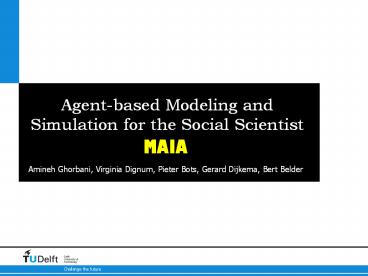Agent-based Modeling and Simulation for the Social Scientist - PowerPoint PPT Presentation
Title:
Agent-based Modeling and Simulation for the Social Scientist
Description:
Agent-based Modeling and Simulation for the Social Scientist MAIA Amineh Ghorbani, Virginia Dignum, Pieter Bots, Gerard Dijkema, Bert Belder The car example, we have ... – PowerPoint PPT presentation
Number of Views:606
Avg rating:3.0/5.0
Title: Agent-based Modeling and Simulation for the Social Scientist
1
Agent-based Modeling and Simulation for the
Social Scientist
- MAIA
Amineh Ghorbani, Virginia Dignum, Pieter Bots,
Gerard Dijkema, Bert Belder
2
Goal
- Framework for agent-based conceptualization and
simulation - Rich enough to capture a diverse range of social
systems - Support developers with little/no
programming/software engineering knowledge - Application areas
- Policy design / public goods problems
- Social systems complex behavior / discrete
entities - Approach
- Collaborative modelling
- Institutional analysis (Ostrom)
- Model driven engineering (MDE)
- meta-modeling and semi-automatic code generation
3
Applications
- Domains
- Commonalities
- Wood-fuel market
- E-Waste recycling
- Consumer lighting
- Basic income grants
- Family-based care
- Domain characteristics
- What-if analysis of policies
- Problem-owners /domain experts had limited
simulation knowledge
4
Common characteristics
- Effect of incentives / policies
- Social networks and institutions
- Individual interests
- Global consequences
- Multi-criteria decision making
5
What is MAIA?
- Modeling Agents based on Institutional Analysis
- Formal meta-model
- Institutional perspective (IAD Ostrom)
- Web based design tool
- Declarative rather than procedural
- Semi-automatic simulation generation
6
MAIA Architecture
- The MAIA meta-model
finetuning
7
Institutions
- An institution is any structure or mechanism of
social order and cooperation governing the
behavior of a set of individuals within a given
human community. - Institutions are identified with a social purpose
and permanence, transcending individual human
lives and intention by enforcing rules that
govern cooperative human behavior
8
Institutions
1- Rules accepted by everyone 2- Used in
practice 3- Durability
By product of interactions
Rules created to manage activities
Individuals do activities (repetitive)
outcomes affect others too
9
Institutional frameworks
- Institutions have two sides
- Enable interactions, provide stability,
certainty, and form the basis for trust. - Cause power relations and may hamper reform.
- Important to understand effects of institutions
Institutional (re)design
Analyze and Understand for Design? Institutional
Frameworks
10
Institutional Analysis and Design
unit of analysis
Elinor Ostrom Nobel laureate 1933-2012
11
Institutional Analysis and Development Framework
(IAD)
- Participants
- Positions
- Actions
- Potential outcomes
- Functions that map actions into outcomes
- Information
- Cost and benefits
- Position rules
- Boundary rules
- Authority rules
- Aggregation rules
- Scope rules
- Information rules
- Payoff rules
Action Arena
Physical world
Action Situation
Patterns of interaction
Community
Evaluation Criteria
Participants
Rules
Outcomes
Resources, preferences, information and selection
criteria
12
Extending IAD
- Formalization of concepts
- MAIA formal model
- Robust information and consensus
- MAIA online tool supports flexible
conceptualization through participatory
exploration - Supports reflection and discussion
- Outward looking
- Information collected directly reflects the
experiences and perceptions of stakeholders
themselves
13
MAIA Meta model
14
Collective structure set of agents
15
Constitutive Structure
16
Institutions ADICO
17
Physical components
18
Operational structure
19
MAIA Modelling Environment
http//maia.tudelft.nl/
20
Translation to Java Code
- MAIA MM is developed as an e-core model
- EMF environment in Eclipse for model-driven
software development. - XML specification.
- Output of MAIA web-tool is based on MAIA MM
- Explicit, fixed, rules to convert MAIA model
(XML) to Java simulation - Current work translator code, for automatic
generation of code from a MAIA-based model.
21
From rules to code
22
Agent behaviour
23
MAIA Approach
declarative
24
Conclusions
- MAIA framework for agent-based simulation
- Rich enough to capture a diverse range of social
systems - Support developers with little/no
programming/software engineering knowledge - Based on Institutional analysis (Ostrom)
- Formal model
- Verification
- Model driven engineering (MDE) for semi-automatic
code generation
25
Future work
- Extend and validate code generation
- Visualisation of simulation results
- Library of agent behaviours
- Extensive evaluation
- Transformation of MAIA models into other
simulation environments (e.g. Netlogo or Repast)
26
Benefits of MAIA
- Four completed case studies 5 other users
- Diverse range of concepts makes you think about
the things that you may need to consider in your
model. - Easy to follow by no-programmers
- Team of Developers
MAIA
MAIA
27
MAIA Architecture
More info a.ghorbani_at_tudelft.nl































